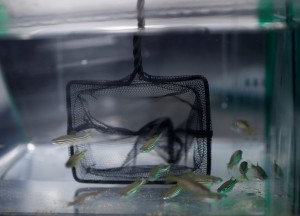
Tiny, sleek zebrafish could hold the key for how we treat muscular dystrophy in the future. Dr. Lisa Maves, a researcher at Seattle Children’s Research Institute, has received a grant from the National Institutes of Health to study drug combinations in zebrafish for Duchenne muscular dystrophy. It’s one of the most common forms of muscular dystrophy and affects males almost exclusively. The condition, caused by a genetic disorder of the X chromosome, gradually weakens the body’s muscles and occurs in about 1 out of every 3,500 boys.
Nick Olson is 7 years old—a redhead with a toothy smile and a stuffed animal named Puppyroni by his side. Nick has Duchenne muscular dystrophy. What does a little boy like Nick have in common with a zebrafish swimming in a tank? Genes. Zebrafish are perfect subjects for muscular dystrophy research because the same genes that caused muscular dystrophy in Nick cause it in zebrafish, too.
“Studying muscular dystrophy in zebrafish can help us determine the best approach to treat patients,” said Maves. “We know certain drugs, like heart medications and steroids, reduce symptoms in patients by targeting different parts of the body systems. We study how well these drugs work together in zebrafish. There could be combinations that perform better, or conversely, we might find combinations that have negative effects.”
The grant funds, nearly $490,000, come from the National Institute of Arthritis and Musculoskeletal and Skin Diseases.
Faster Research Results
Maves, who is an investigator in the Center for Developmental Biology and Regenerative Medicine, can administer a drug combination to the zebrafish and know the results within 4-5 days because the animals grow quickly and show disease progression at juvenile stages. This quick turnaround, along with the ability to apply different drug combinations simultaneously to different fish, means the results could soon help clinicians make decisions on what drug combinations to prescribe to patients.
Duchenne muscular dystrophy occurs because of a problem with the gene that produces dystrophin, a protein necessary to make normal muscle cells. Without dystrophin, muscles break down and a child becomes weaker. Symptoms usually appear around age 3 as the pelvic muscles weaken, and most kids need a wheelchair by age 12. Over time, their muscles weaken in the shoulders, back, arms and legs. Eventually, the respiratory muscles are affected, and most boys and young men will require support to assist breathing.
Maves will test the drug combinations on zebrafish embryos. By monitoring biomarkers (a biological indication of a disorder) and gene expression markers that change in the fish as they develop the disease, she can track the effects of different drug combinations.

A Progressive Condition
Nick goes to physical therapy, water therapy and wears braces at night decorated with the Seahawks emblem. He also does stretches. Mike and Darcy Olson are helping their young boy form good habits because as he grows, the muscular dystrophy will weaken his muscles and movement.
“He gets annoyed with some of it,” said Mike Olson. “He asks, ‘Why do I have to do all this?’”
Nick knows he has muscular dystrophy and that his muscles are different, but his parents try not to discuss the condition with him too much. Right now, he is a bright, energetic boy who can move around on his own. The initial diagnosis, when Nick was five, left the Olsons stunned.
“We stopped breathing for about a week,” said Darcy Olson.
But a friend of Mike Olson’s, a doctor whose son also has Duchenne muscular dystrophy, gave them some advice to cope with the diagnosis.
“The advice I got shortly after his diagnosis was, ‘It’s a slow, progressive condition, so you have time to adjust and react as each stage develops,’” said Mike Olson. “The friend said, ‘You don’t need to rush into any decisions on his care. Deal with the emotions of the diagnosis first.'”
Dr. Susan Apkon oversees Nick’s care at Seattle Children’s. He is treated with a steroid called Deflazacort, which prolongs walking abilities in boys who have Duchenne muscular dystrophy and keeps them on their feet 2-3 years longer than boys who do not take it.
“Nick is smart, funny and incredibly engaging,” said Apkon. “I know I will have a great day when I see his name on my schedule.”
Looking Ahead
Research and trials for muscular dystrophy offer hope for the Olson family, whose son will experience more symptoms as he gets older and the condition progresses.
“We want to see positive results from clinical trials and research,” said Mike Olson.

The Olsons are hopeful about a clinical drug trial led by Apkon. She says it’s important to know that a clinical trial is just that—an experiment. Until results come in, it remains to be seen if this drug can help kids like Nick keep their mobility.
“I get anxious and start to hope that this will be the drug that provides a solution,” said Darcy Olson.
The research on zebrafish in Maves’ lab could help clinicians like Apkon develop better drug regiments for patients. The lab research is already complementing patient treatment: One of Apkon’s muscular dystrophy patients is in a clinical drug trial for Ataluren—a drug that Maves is testing on zebrafish.
In the meantime, Nick has had a busy summer. He appeared in a theatrical performance of “Aladdin” as a thief who runs onto the stage and has a line. His favorite subject is math, and he’d like to become a second grade teacher like his mom.
On the day we spoke with him, Nick had visited the Hiram M. Chittenden Locks in Ballard where he saw fish swimming to their natal rivers. But there could be another fish—a zebrafish in Lisa Maves’ lab—that holds the key to a cure for his muscular dystrophy.
To donate to muscular dystrophy research at Seattle Children’s, click here and specify Maves Lab Research Support Fund.
Resources
- Seattle Children’s Rehabilitation Medicine Website
- Dr. Lisa Maves’ page on Seattle Children’s Website
- National Institutes of Health
- KOMO video: Seattle Children’s Research Institute’s Faces of Research – Meet Dr. Lisa Maves

